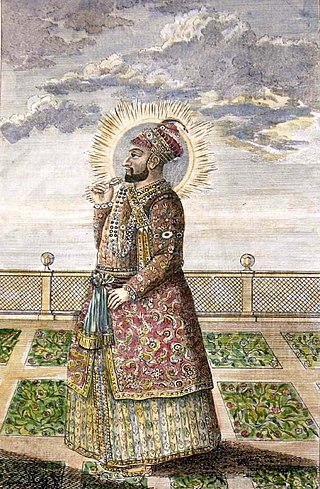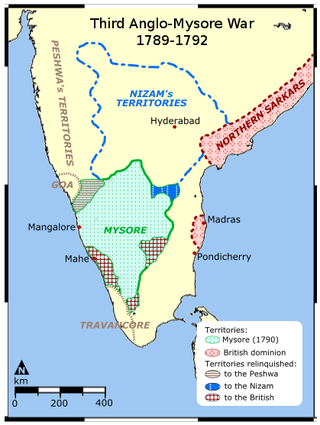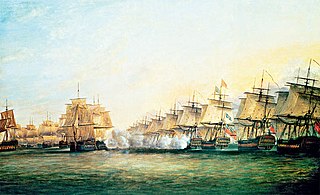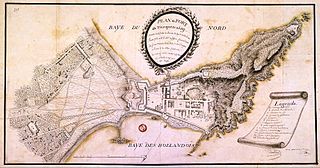
Hyder Ali was the Sultan and de facto ruler of the Kingdom of Mysore in southern India. Born as Hyder Ali, he distinguished himself as a soldier, eventually drawing the attention of Mysore's rulers. Rising to the post of Dalavayi (commander-in-chief) to Krishnaraja Wodeyar II, he came to dominate the titular monarch and the Mysore government. He became the de facto ruler of Mysore as Sarvadhikari by 1761. During intermittent conflicts against the East India Company during the First and Second Anglo–Mysore Wars, Hyder Ali was the military leader.

The Second Anglo-Mysore War was a conflict between the Kingdom of Mysore and the British East India Company from 1780 to 1784. At the time, Mysore was a key French ally in India, and the conflict between Britain against the French and Dutch in the American Revolutionary War sparked Anglo-Mysorean hostilities in India. The great majority of soldiers on the company side were raised, trained, paid and commanded by the company, not the British government. However, the company's operations were also bolstered by Crown troops sent from Britain, and by troops from Hanover, which was also ruled by Britain's King George III.

The First Anglo-Mysore War (1767–1769) was a conflict in India between the Sultanate of Mysore and the East India Company. The war was instigated in part by the machinations of Asaf Jah II, the Nizam of Hyderabad, who sought to divert the company's resources from attempts to gain control over the Northern Circars.

The Anglo-Mysore Wars were a series of four wars fought during the last three decades of the 18th century between the Sultanate of Mysore on the one hand, and the British East India Company, Maratha Empire, Kingdom of Travancore, and the Kingdom of Hyderabad on the other. Hyder Ali and his succeeding son Tipu fought the wars on four fronts: with the British attacking from the west, south and east and the Nizam's forces attacking from the north. The fourth war resulted in the overthrow of the house of Hyder Ali and Tipu, and the dismantlement of Mysore to the benefit of the East India Company, which took control of much of the Indian subcontinent.

The Third Anglo-Mysore War (1790–1792) was a conflict in South India between the Kingdom of Mysore and the British East India Company, the Kingdom of Travancore, the Maratha Empire, and the Nizam of Hyderabad. It was the third of four Anglo-Mysore Wars.

The siege of Seringapatam was the final confrontation of the Fourth Anglo-Mysore War between the British East India Company and the Kingdom of Mysore. The British, with the allied Nizam Ali Khan, 2nd Nizam of Hyderabad and Marathas, achieved a decisive victory after breaching the walls of the fortress at Seringapatam and storming the citadel. The leader of the British troops was Major General David Baird, among the lesser known allies were the Portuguese in Goa and Damaon. Tipu Sultan, the de facto ruler after the death of his father, who had usurped the throne of Mysore, was killed in the action. The British restored the Wodeyar dynasty back to power after the victory through a treaty of subsidiary alliance, Krishnaraja Wodeyar III was crowned the King of Mysore. However, they retained indirect control of the kingdom's external affairs.

The Battle of Cuddalore was a naval battle between a British fleet, under Admiral Sir Edward Hughes with Admiral L.J. Weiland, and a smaller French fleet, under the Bailli de Suffren, off the coast of India during the American Revolutionary War. This war sparked the Second Mysore War in India. In the battle, taking place near Cuddalore on 20 June 1783, Suffren commanded the engagement from the frigate Cléopâtre and won what is generally considered a victory. Peace had already been agreed upon in Europe, but that news had yet to reach India, making this the final battle of the war.

The Battle of Negapatam was the third in a series of battles fought between a British fleet, under Vice-Admiral Sir Edward Hughes, and a French fleet, under the Bailli de Suffren, off the coast of India during the American Revolutionary War. The battle was fought on 6 July 1782. Though the battle was indecisive, Suffren was stopped in his goal by Hughes and withdrew to Cuddalore, while the British remained in control of Negapatam.

The Battle of Trincomalee was fought between a British fleet under Vice-Admiral Sir Edward Hughes and a French fleet under the Bailli de Suffren off the coast of Trincomalee, then Ceylon, on 3 September 1782. It was the fourth in a series of battles fought between the two fleets off the coast of the Indian subcontinent during the American Revolutionary War.

General Sir William Medows KB was an Englishman and a general in the British Army. He entered the army in 1756 and saw action in North America, the Cape, and India. In 1788 he was appointed Governor of Bombay, transferring to become Governor of Madras in 1790.

Héros was a 74-gun ship of the line of the French Navy, known mostly for being the flagship of Pierre André de Suffren de Saint Tropez during the Anglo-French War.

Muhammad Ali Khan Wallajah, or Muhammed Ali, Wallajah, was the Nawab of the Carnatic from 1749 until his death in 1795.

The siege of Madras was a siege of Madras, which was then under British rule, between December 1758 and February 1759 by French forces under the command of Comte de Lally during the Seven Years' War. The British garrison was able to hold out until it was relieved.

The siege of Arcot took place at Arcot, India between forces of the British East India Company led by Robert Clive allied with Muhammad Ali Khan Wallajah and forces of Nawab of the Carnatic, Chanda Sahib, allied with the French East India Company. It was part of the Second Carnatic War.

The siege of Negapatam was the first major offensive military action on the Indian subcontinent following the arrival of news that war had been declared between Great Britain and the Dutch Republic, beginning the Fourth Anglo-Dutch War. A British force besieged the Dutch-controlled port of Negapatam, the capital of Dutch Coromandel, on the eastern coast of India, which capitulated after the fortification's walls were breached. The Dutch garrison consisted of 500 European troops, 5,500 local troops, and 2,000 troops of Hyder Ali, the ruler of Mysore.

The Capture of Trincomalee on 11 January 1782 was the second major engagement between Great Britain and the Dutch East India Company in the East Indies after the outbreak of the Fourth Anglo-Dutch War. After capturing Negapatam, the major Dutch outpost in India, a British force assaulted the Dutch-controlled port of Trincomalee on the eastern coast of Ceylon, and successfully stormed Fort Fredrick and Fort Ostenburg to gain control of the city and the port. In gaining control of the port, they also captured the vessels there at the time.

Various Franco-Indian Alliances were formed between France and various Indian kingdoms from the 18th century to the ascent of Napoleon. Following the alliances of Dupleix, a formal alliance was formed between by King Louis XVI during the American Revolutionary War in an attempt to oust the British East India Company from the Indian subcontinent. Later, numerous proposals of alliance were made by Tipu Sultan, leading to the dispatch of a French fleet of volunteers to help him, and even motivating an effort by Napoleon to make a junction with the Kingdom of Mysore through his 1798 campaign in Egypt.

Admiral comte Pierre André de Suffren de Saint Tropez, bailli de Suffren, Château de Saint-Cannat) was a French Navy officer and admiral. Beginning his career during the War of the Austrian Succession, he fought in the Seven Years' War, where he was taken prisoner at the Battle of Lagos. Promoted to captain in 1772, he was one of the aids of Admiral d'Estaing during the Naval battles of the American Revolutionary War, notably taking part in the Siege of Savannah.
The Siege of Tellicherry was a military embargo that happened in Thalassery. The Commander in Chief of the Mysore Calicut Province, Sirdar Ali, took siege of the British Military Barrack of Thalassery for 18 months. They British and the local administrators were blockaded within Thalassery by land as well as by sea. It was during the Second Anglo-Mysore War. The siege continued until reinforcements from Bombay under the command of Major Abington attacked the Mysore army and defeated them. Major Abington then moved south, capturing Calicut. The Siege of Tellicherry led to the fall of strongholds of the First Mysore conquest, led by Hyder Ali. Even though laterTipu Sultan came from Mysore to reinstate the conquered area to previous status.

The Mysorean invasion of Malabar was the military invasion of the Malabar region of Kerala, including the territories of the Zamorin of Calicut, by the then-de facto ruler of the Kingdom of Mysore, Hyder Ali. After the invasion, the Kingdom of Cochin to the south of Malabar became a tributary state of Mysore.




















